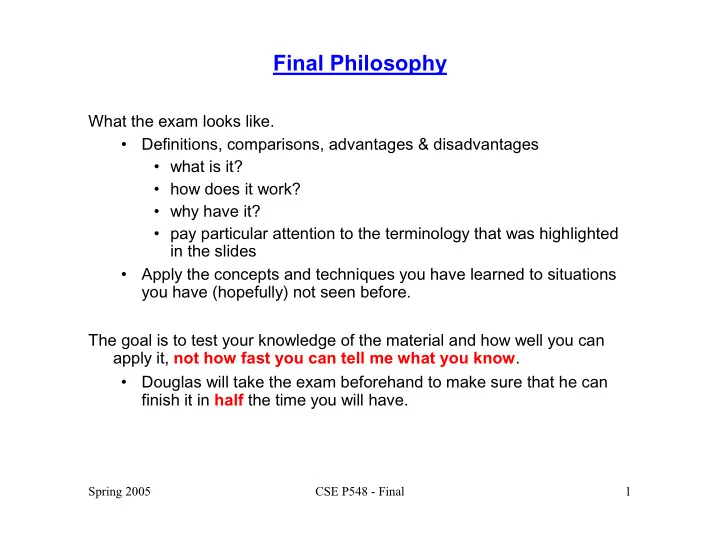

Final Philosophy What the exam looks like. • Definitions, comparisons, advantages & disadvantages • what is it? • how does it work? • why have it? • pay particular attention to the terminology that was highlighted in the slides • Apply the concepts and techniques you have learned to situations you have (hopefully) not seen before. The goal is to test your knowledge of the material and how well you can apply it, not how fast you can tell me what you know . • Douglas will take the exam beforehand to make sure that he can finish it in half the time you will have. Spring 2005 CSE P548 - Final 1
Topics Architecture vs. implementation Design principles RISC vs. CISC • Enforcing backwards compatibility • New instructions & the rationale for including them ILP & TLP Pipelining • Dependences vs. hazards • Techniques to eliminate hazards • Precise Interrupts & pipelining Techniques to reduce branch delays • Dynamic branch prediction • Branch target buffers Spring 2005 CSE P548 - Final 2
Topics Static & dynamic scheduling • Techniques for static scheduling • Implementations of dynamic scheduling • Tomasulo • Physical register pool • Reorder buffers • Preserving precise interrupts • VLIW computers • Superscalars vs. VLIW processors Multithreaded processors • Coarse-grain, fine-grain & SMT Spring 2005 CSE P548 - Final 3
Topics Caches • Configuration tradeoffs • Hardware & compiler techniques to hide memory latency, reduce memory latency, eliminate memory ops, increase memory bandwidth Multiprocessors • The religious war: SM vs. MP • Cache coherency on bus-based & distributed MIMDs • Synchronization Dataflow machines Spring 2005 CSE P548 - Final 4
Recommend
More recommend